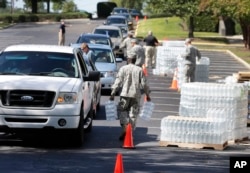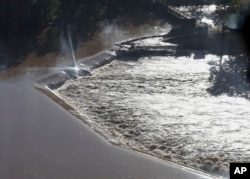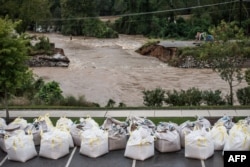The sun shone on the Carolinas Tuesday after a week straight of being pummeled by historic rains that led to 16 deaths, widespread flooding and burst dams.
Yet, the worst isn't over.
"Don't let the sunshine fool you," South Carolina Governor Nikki Haley said. "We are still in the mode that the next 36 to 48 hours will be volatile."
Haley took an aerial tour of the flooding and damage Tuesday and said, "We still have to be cautious. ... What I saw was disturbing.''
Tuesday was the first completely dry day in Columbia since September 24, but officials warned that new evacuations could be ordered as several rivers remained above flood stage, sending a huge mass of water flowing toward the sea, threatening dams and displacing residents along the way.
Rising death toll
At least 14 weather-related deaths in South Carolina and two in North Carolina were blamed on the vast rainstorm, described by the National Oceanic and Atmospheric Administration as a "fire hose" of tropical moisture aimed directly at the state.
Haley said it was too soon to put a price tag on the amount of damage the state has suffered, saying it could be "any amount of dollars," although some insurance experts were saying it would be well over $1 billion.
The governor asked for and received a federal disaster declaration from President Barack Obama, freeing up money and resources for the state.
State residents reeled under the effects of weekend flooding.
Water issues
In Columbia, the state capital, as many as 40,000 homes lacked drinking water, and the rest of the city's 375,000 customers were told to boil water before using it for drinking or cooking, an order that Mayor Steve Benjamin said will likely be in effect for "quite some time."
On Tuesday, about 800 people were in two-dozen shelters, but Haley said that number was expected to rise in the coming days. While nearly 30,000 customers were without electricity at the storm's peak over the weekend, the power grid had returned to normal by Tuesday afternoon, officials said.
A tropical air mass over much of South Carolina since Thursday dumped up to 51 centimeters (20 inches) of rain in some parts of the state between Friday and Sunday, the National Weather Service said.
Infrastructure failings
In South Carolina there are about 2,400 dams, almost all privately owned, according to media reports.
At least 10 of them have failed in the past few days, state officials said Tuesday.
Emergency management officials said about 300 state-maintained roads and 160 bridges remained closed, with about 200 engineers checking the structures for safety.
Many of the closures are in the Columbia area, which registered record rainfall this week and where as many as six people drowned in their cars from flooding.
Haley stressed the need for motorists to mind police barricades on flooded roads after reports of people moving the barricades or driving around them. "We are doing this to protect you," she said.
Members of the South Carolina National Guard were also called in to assist state and county emergency crews and first responders.
Highway closed
A 120-kilometer (75-mile) stretch of Interstate 95 was also closed Tuesday due to flooding and overall poor road conditions.
Also Tuesday, the University of South Carolina in Columbia, which has more than 30,000 students, canceled classes for the rest of the week. The campus doesn't have full water capacity and has brought in more than 150 portable restrooms.
The 42.2 centimeters (16.6 inches) of rain that fell at Gills Creek near downtown Columbia on Sunday made for one of the rainiest days recorded at a U.S. weather station in more than 16 years.
Some material for this report came from AP and Reuters.













